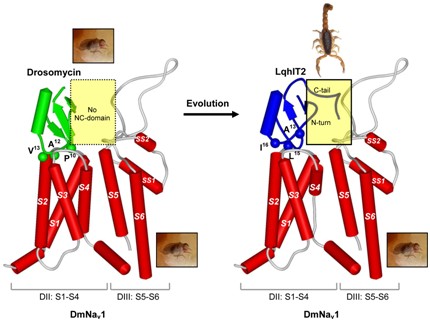- Computational Genomics-Based Gene Discovery of Antimicrobial Peptides from Insects
Taking advantage of evolutionarily conserved primary, secondary and tertiary structural information of antimicrobial peptides, we seek to mine the full set of antimicrobial peptide gene sources from the sequenced genome of a given model insect species by using bioinformatics approaches. With the combination of a large-scale evolution-guided functional characterization strategy, we try to establish the antimicrobial peptide blueprint of several representative model insects and to understand their possible involvement in antibacterial immunity of insects in a synergic manner.
- Ion Channel-Targeted Neurotoxins: Development of Pesticide Leads
Scorpion venom is a rich source of neurotoxins targeting ion channels. Our efforts are to reveal molecular and evolutionary mechanisms of functional diversification and target transfer of these unique peptide scaffolds. Guided by the knowledge, we will try to design high insect-selective peptide pesticide leads.
- Evolution of Neurotoxins from Ancestral Defensin Scaffold
Both antimicrobial defensins and animal neurotoxins are membrane-active compounds and adopt a similar structural scaffold in some cases. We seek to establish an ancestral role of antimicrobial defensins in the origination of arthropod venom-derived neurotoxins targeting ion channels.
- Development of New Types of Scaffolds from Defensin Structures
Grafting of exogenous functional motifs onto an unrelated structural scaffold represents a major research direction in protein engineering. The defensin fold comprises a large superfamily of peptides with diverse biological functions, such as antimicrobial and neurotoxic activity, and stable three-dimensional structures. Our efforts are to explore their scaffold potential to generate a series of engineering peptides with specific biological functions.


